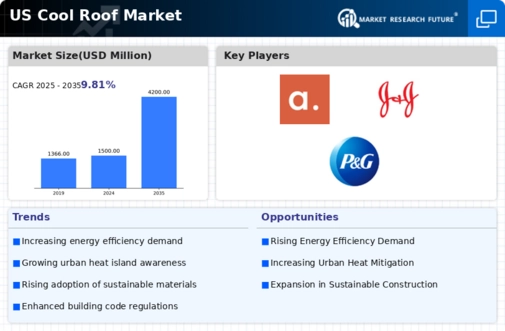Rising Urban Heat Island Effect
The increasing prevalence of urban heat islands (UHIs) in metropolitan areas is a critical driver for the cool roof market. As cities expand, they tend to absorb and retain heat, leading to elevated temperatures compared to surrounding rural areas. This phenomenon can raise energy consumption for cooling by up to 30%, prompting municipalities to seek solutions. Cool roofs, which reflect more sunlight and absorb less heat, present an effective strategy to mitigate UHI effects. The cool roof market is likely to benefit from heightened awareness and demand for sustainable building practices that address these temperature disparities. Furthermore, cities are increasingly implementing policies to promote cool roofing technologies, thereby enhancing market growth prospects. The potential for energy savings and improved urban livability positions cool roofs as a viable solution to combat the UHI effect.
Climate Change Mitigation Efforts
The ongoing efforts to combat climate change are increasingly shaping the cool roof market. As the impacts of climate change become more pronounced, there is a growing emphasis on sustainable building practices that can help reduce greenhouse gas emissions. Cool roofs contribute to this goal by lowering energy consumption and minimizing the heat released into the atmosphere. The cool roof market is likely to see increased investment and support from both public and private sectors as part of broader climate action initiatives. Furthermore, the integration of cool roofing technologies into building codes and standards may become more prevalent, further driving market growth. The potential for cool roofs to play a role in achieving climate targets positions them as a critical component of sustainable urban development.
Government Incentives and Policies
Government incentives and policies are playing a pivotal role in shaping the cool roof market. Various federal and state programs are designed to encourage the adoption of energy-efficient technologies, including cool roofs. These initiatives often include tax credits, rebates, and grants that make it financially attractive for property owners to invest in cool roofing solutions. The cool roof market is likely to benefit from these supportive measures, as they lower the initial investment barrier for consumers. Additionally, regulatory frameworks that mandate energy efficiency standards in new constructions are expected to further propel the adoption of cool roofs. As more jurisdictions implement such policies, the market for cool roofing technologies is anticipated to expand significantly.
Increased Energy Efficiency Awareness
Growing awareness regarding energy efficiency is significantly influencing the cool roof market. As energy costs continue to rise, consumers and businesses are becoming more conscious of their energy consumption patterns. Cool roofs can reduce energy use for air conditioning by approximately 10-15%, which translates into substantial cost savings over time. This awareness is driving both residential and commercial sectors to adopt cool roofing solutions as a means to lower energy bills and reduce carbon footprints. The cool roof market is poised to expand as more stakeholders recognize the long-term financial and environmental benefits associated with energy-efficient roofing options. Additionally, educational campaigns and outreach programs are likely to further enhance public understanding of the advantages of cool roofs, thereby stimulating market demand.
Technological Innovations in Roofing Materials
Technological advancements in roofing materials are driving innovation within the cool roof market. The development of new reflective coatings and materials that enhance the performance of cool roofs is a key factor in market growth. Innovations such as advanced polymers and reflective granules can improve the durability and effectiveness of cool roofing systems. The cool roof market is likely to see increased competition as manufacturers strive to create superior products that meet evolving consumer demands. Furthermore, the integration of smart technologies, such as sensors that monitor roof temperature and performance, may enhance the appeal of cool roofs. As these technologies continue to evolve, they could potentially reshape the landscape of the cool roof market, offering new opportunities for growth and differentiation.














Leave a Comment